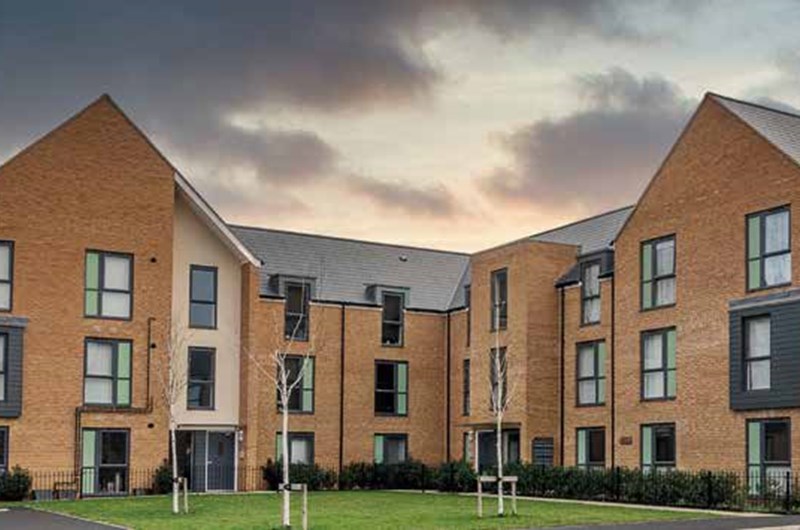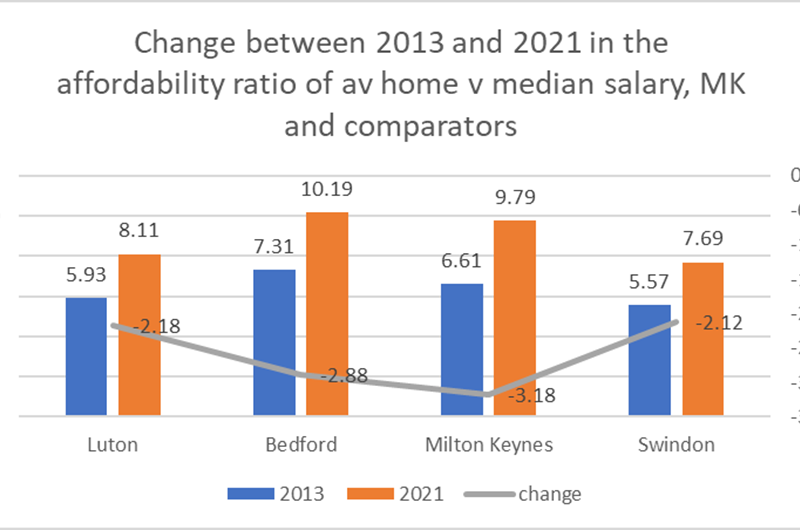SDG - SUSTAINABLE CITIES AND COMMUNITIES
Theme Definition
Access to affordable, good quality housing provides families and individuals with a sense of security and stability. Poor or unstable housing is associated with poor physical and mental health. [1]

Milton Keynes is ranked 23rd out of all 317 local authorities in England for barriers to housing and services (in the 2019 Indices of Multiple Deprivation, where 1= high barriers).
This indicates that those who are disadvantaged experience particular challenges in relation to housing.
The rate of new home building has not kept up with the rate of demand, particularly for low cost, affordable options and rental properties.
This is despite Milton Keynes Council’s policy to require developers to build affordable homes as part of new housing developments.
Many of the estates built in the 1970s are now in need of substantial investment to ensure that the homes meet modern standards, and over half of the first phase housing estates rank amongst the highest in the UK for levels of deprivation. [2]
Homelessness in young adulthood is closely associated with poverty especially in childhood. Other higher risk factors are health needs, serious drug use, lack of social support networks and living in a high-cost housing area. [3]
The immediate cause of homelessness in Milton Keynes is around relationships – family and friends no longer able to accommodate the person/household, or because of domestic abuse or violence and relationship breakdown.
The prevalence of rejection and abuse of young LGBTQ+ people by their families is a major contributor to their becoming homeless. This is particularly experienced by those who are from Ethnically Diverse communities. [3]
Comparative data on homelessness is not available prior to 2018 when new ways of measuring homelessness were introduced as part of the Homelessness Reduction Act 2017.
Affordability
There is gap that is becoming wider in relation to income levels and prices of homes in Milton Keynes.
The lack of affordable of housing is the underlying cause of homelessness [4]

Getting a foothold into housing among young, disadvantaged people:
The YMCA provides housing support to young people who are not working or in low-paid jobs, and with no family support.
Many are vulnerable and have a background of trauma, have experienced domestic abuse or have been involved in the criminal justice system.
Since 2020, due to the impact of the COVID-19 pandemic, there has been a 150% increase in demand for housing and an increase in the number of YMCA residents with complex mental health needs.
“We are trying to have a deep and powerful impact over the 3 years that the young person is with us, so that they leave us feeling confident, more resilient and with a vision for their own future.”
Simon Green, Chief Executive Milton Keynes YMCA.
Comparative figures from ten years on YMCA residents:
YMCA data highlights that since 2013 it is more difficult for young people, when they move on from YMCA accommodation, to get into private accommodation, and more need to stay with friends and family.
- Those moving in with friends/family/partner has increased from 15% to 39%
- Those moving into Supported Housing has decreased from 18% to 3%
- Those moving to private rented has decreased from 43% to 16%
Rough Sleeping
There has been a reduction in Milton Keynes in rough sleeping since the establishment in 2017 of a Rough Sleeper Outreach Service funded by the Department of Communities and Local Government.
People who sleep rough experience some of the most severe health inequalities and report much poorer health than the general population. Many have co-occurring mental ill health and substance misuse needs, physical health needs, and have experienced significant trauma. [5]
Temporary Accommodation
The high rates of those in temporary accommodation reflect the shortage of affordable housing in Milton Keynes in relation to demand.
The rate per 1000 households living in temporary accommodation, secured by Milton Keynes Council as part of their statutory duty towards homeless households, is 8 per 1,000, more than double the rate for England which is 3.98 per 1,000 households, as at March 2022.
Data from the charity Shelter estimates the numbers of people, rather than households, who are homeless.
It uses a broader definition of homelessness:
‘those living in temporary accommodation arranged by their local council, or by themselves, or are legally homeless but still living in their home and are yet to be moved into temporary accommodation.’
Based on these definitions Milton Keynes is ranked 27 out of all English Local Authorities for the rate of homelessness in the population.
A rank of 1 is the highest rate of homelessness). The situation has worsened – the 2018 rank was 32.
More temporary accommodation has become available to Milton Keynes Council through the building of housing association homes and the policy that gives the Council the right to decide to whom some accommodation should be allocated.
Housing and the COVID-19 Pandemic
Milton Keynes Homelessness Partnership set up in 2018 to foster collaboration across public, private and voluntary sector organisations, identified that:
"One of the shining lights that came from the Pandemic response was the way in which the sector worked together to achieve the goals."
Its data showed that during the COVID-19 Pandemic, more people confronted the possibility of homelessness as a result of reduction in income due to furlough or unemployment or relationship breakdown and domestic abuse.
Protections introduced during the COVID-19 Pandemic prevented evictions from rental housing, and numbers becoming homeless for rent arrears fell in 2021 in Milton Keynes.
Milton Keynes Council has commented that the ‘Everyone in' policy increased the need for temporary housing.
The policy embraced those who are categorised as ‘having no recourse to public funds’, who usually are not able to access statutory support services. (I.e. all migrants granted limited rights to be in the UK such as partners, spouses, children and adult dependent relatives.)
Vital Statistics - Housing
- Over half of Milton Keynes first phase housing estates rank amongst the highest in the UK for levels of deprivation.
- The ratio of mean annual salary to mean house price in MK was 6.6 in 2013 and increased to 9.8 in 2021.
- Milton Keynes was ranked 27 out of all English Local Authorities in 2021 for the proportion of its population that was homeless (a rank of 1 is the highest proportion that are homeless). In 2018 Milton Keynes ranking was 32.
- 65% of households become homeless in Milton Keynes due to the impact of relationship breakdowns or family/friends no longer being able to accommodate.
- The rate of households living in temporary accommodation is 8 per 1,000 households, double the average rate for England.
Vital Thinking
How do we support newly arrived communities to be welcomed and integrated into Milton Keynes?
Make an enquiry
Have any questions? Our team would love to chat with you!
